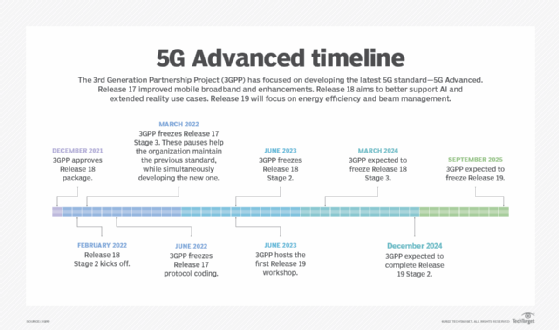The next major chapter in 5G development will focus on the arrival of 5G Advanced.
Basically, 5G Advanced is another name for the upcoming 5G cellular specification Release 18 and its future releases. The 3rd Generation Partnership Project (3GPP) unveiled the concept of 5G Advanced in its proposed Release 18 package for 2021. The previous specification, Release 17, introduced beam management enhancements and mobile broadband enhancements. Release 18 and future Release 19 build on these specifications and aim to enhance support for AI, augmented reality (XR), and energy efficiency.
The 5G standard began in late 2017 with the announcement of the technology’s new non-standalone radio (NR) specification. The early stages of 5G deployment are well underway in the United States, with carriers deploying 5G on fixed and mobile networks in thousands of metropolitan areas.
Now that 5G technology has reached most people, next on the list is the arrival of the 5G Advanced specification. 3GPP said the standard “has been significantly enhanced to add functionality as well as improve efficiency.”
New features of 5G Advanced
Nokia Bell Labs said in a white paper on upcoming standards and future mobile advances that 5G Advanced will have “advanced features with new services, greater connectivity and security.”
Below are some of the features and benefits of 5G Advanced.
Massive MIMO improvements
5G Advanced provides enhanced massive multiple input, multiple output (MIMO) performance for 5G network operations. MIMO is an antenna array technology that uses multiple antennas at both the transmitter and receiver to increase data transfer rates. Massive MIMO is a multi-user upgrade that increases the number of transmitter and receiver components.
Bell Labs anticipates that 5G Advanced and future standards will require base stations that support 64 to 512 transceivers. A transceiver is an antenna element that both transmits and receives data to increase uplink and downlink capacity per base station. For enterprise users, this means that his updated 5G Advanced system will better support high-throughput data users on the network and improve indoor cellular network connectivity. This is especially true for industrial wireless sensors, which are often installed in underground facilities.
Users will need to deploy new infrastructure and devices to increase future speeds at the network edge.
exact timing
Precise millisecond timing is critical to many industrial sectors such as banking, industrial IoT, and smart energy grid technologies. 5G Advanced provides a time reference directly from the network, preventing satellite signal degradation or loss, Nokia writes.
The upgrades starting with 3GPP Release 17 also affect enterprise users. Non-terrestrial network updates will allow compatible devices to connect to his 5G satellites. Another major update is the reduction in data rates for wearables and his IoT devices.
decline in ability
Release 17 introduced feature reduction (RedCap) as part of the specification. RedCap talks about 5G NR and explains how 5G-enabled devices use less bandwidth to operate. Wearable and IoT devices using RedCap can operate on 20 MHz channels instead of the 100 MHz channels typically used by 5G NR.
Qualcomm says Release 18 reduces the bandwidth required for RedCap devices while maintaining compatibility with existing 5G NR and RedCap devices.
mobile augmented reality
Business use cases for XR, a subset of augmented reality (AR), are increasing at a consistent rate. An example is:
- Train and onboard new employees using AR mobile device headsets.
- Guide the technical engineer to the equipment to be worked on.
- Remote collaboration in virtual space.
XR requires high-resolution images up to 4K 60 frames per second for real-time streaming indoors. Therefore, the benefits of improved low-latency performance, concurrent user connections, indoor reliability, and traffic prioritization offered by 5G Advanced will reduce the hurdles for a truly immersive XR experience in many markets. .
5G Advanced and AI
5G Advanced uses AI and machine learning (ML) to apply intelligent network management to improve the performance of complex multi-antenna systems. According to Ericsson, this support further expands his XR use case for combining AR and ML.
The main goal of 5G Advanced is to enable more energy-efficient networks. This will be possible by implementing AI and ML updates on the network, Ericsson said. 3GPP said it is defining a power efficiency consumption model for base stations as part of the Release 18 specification. It also aims to determine how the standard can reduce power.
Improved positioning
With the Release 18 specification, enterprise users can benefit from advanced positioning. Nokia said 5G Advanced “improves mobile phone positioning accuracy to less than 10cm by using beamforming and time-based methods to determine location.” These improvements allow machines to move indoors with centimeter accuracy without accessing GPS satellite signals.

Operator advances
Although 5G Advanced is still in its early stages, carriers are preparing for the next phase of 5G.
“Release 18 supports many system enhancements and vertical service support, from XR experiences to artificial intelligence and machine technology in the network,” said Brian Daly, assistant vice president of standards and industry alliances at AT&T Labs. says Mr. “However, these specifications will not be completed until early 2024.”
Daly said he expects the features in Release 18 to be in products within 18 to 24 months of development. Therefore, it is expected that commercial upgrades to 5G Advanced will likely not start until late 2025 or early 2026. However, data rates, locations, timing, and coverage are set to improve, so enterprise users should pay attention to the latest phase of 5G and consider how to upgrade. To get the most out of new features.
Editor’s note: This article was originally written by Dan Jones and updated by Andrew Froehlich to reflect changes in technology.
Andrew Froehlich is the founder of InfraMomentum, an enterprise IT research and analysis firm, and president of West Gate Networks, an IT consulting firm. He has been involved in enterprise IT for over 20 years.


